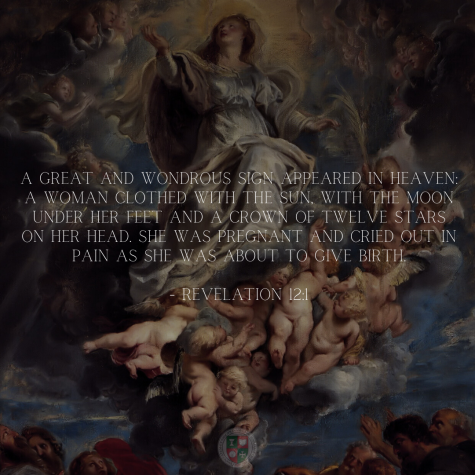“A woman clothed with the sun” – The History & Significance of the Assumption of The Blessed Virgin Mary
August 16, 2023

The Feast Day of the Assumption of the Virgin Mary, celebrated on August 15th, holds a special place in the hearts of millions around the world. This revered day commemorates a profound event in Christian tradition — the bodily assumption of the Virgin Mary into heaven. This article delves into the significance and history of this remarkable feast, exploring its origins, religious importance, cultural impact, and contemporary observance.
Origins and Religious Significance:
The Assumption of the Virgin Mary is rooted in ancient Christian belief, though the exact details may vary among different Christian denominations. It centers around the idea that Mary, the mother of Jesus Christ, was taken up into heaven, both body and soul, at the end of her earthly life. While this event is not explicitly described in the New Testament, it has been passed down through oral tradition and apocryphal writings.
The significance of the Assumption lies in its affirmation of Mary’s unique role in salvation history. As the mother of Jesus, her assumption into heaven symbolizes her closeness to her divine Son and her participation in his redemptive work. This event underscores the dignity of Mary as the Theotokos (God-bearer) and her exalted position as a model of faith and devotion.
Historical Development:
The Assumption’s origins can be traced back to the early Christian centuries. Some of the earliest references to Mary’s bodily assumption can be found in apocryphal texts, such as the “Transitus Mariae” or the “Dormition of Mary.” These writings, though not included in the official canon of Scripture, helped shape the popular devotion to Mary’s assumption.
In the Byzantine Empire, the Feast of the Dormition (falling asleep) of the Theotokos gained prominence, celebrating Mary’s peaceful death and subsequent assumption. Over time, this feast evolved into what is now known as the Feast of the Assumption in the Roman Catholic Church and various Orthodox traditions.
Papal Recognition and Dogma:
The celebration of the Assumption gained greater recognition over the centuries, and its importance was solidified in the 20th century. In 1950, Pope Pius XII declared the dogma of the Assumption through the Apostolic Constitution “Munificentissimus Deus.” This official proclamation asserted that “the Immaculate Mother of God, Mary ever Virgin, when the course of her earthly life was finished, was taken up body and soul into heavenly glory.”
Cultural Impact and Contemporary Observance:
The Feast of the Assumption has left an indelible mark on art, literature, and cultural practices. Countless masterpieces depict Mary’s ascent into heaven, capturing the awe and reverence surrounding this momentous event. Pilgrimages to Marian shrines, such as Lourdes and Fatima, have become popular traditions, where believers gather to honor Mary and seek her intercession.
Today, the Assumption remains a significant feast in both the Roman Catholic and Orthodox calendars. It is marked by liturgical celebrations, processions, and the blessing of herbs and flowers. In many countries, the feast also holds cultural and secular significance, with public holidays and festivals celebrating Mary’s assumption.
The Feast of the Assumption of the Virgin Mary stands as a testament to the enduring devotion of countless believers across the ages. Its historical roots, religious significance, and cultural impact have contributed to its enduring relevance in the lives of Christians worldwide. As the faithful gather to celebrate this feast, they continue to honor Mary’s unique role in the story of salvation and draw inspiration from her example of unwavering faith and devotion.
Categories
Discerning, a Vocations BlogGeneral News
Stirrings
Uncategorized
Celebrating 50 Years of Faithful Service: Fr. Jim Blocher, CSB
Fr. Paul English, CSB (left) Fr. Blocher CSB (center) and Fr. Morgan Rice, CSB (right). Fr. Paul English, CSB, and Fr. Morgan Rice, CSB, recently made a special visit […]
Read MoreTwo New Basilian Priests Ordained in Tlalpan
The Congregation of St. Basil joyfully celebrated the ordinations of Fr. Julio César Martínez Chávez, CSB and Fr. José de Jesús Rodríguez Pérez, CSB in Tlalpan, Mexico City! […]
Read MoreBasilian Scholastics Gather in Tlalpan
Basilian Scholastics are gathering in Tlalpan, Mexico City for their annual Scholastic Gathering. This year’s theme centers around Christus Vivit (“Christ Is Alive”), Pope Francis’s Apostolic Exhortation to young people […]
Read MoreBasilians Welcome Two Novices in Tehuacán, Mexico
Fr. Maurice Restivo, CSB received two novices—Ciro Alfonso Cárdenas Balaguera (Colombia) and Fabien Mwehu Itondo (Mexico)—into the Basilian Novitiate at Casa San Felipe in Tehuacán, Mexico. Please keep Ciro and […]
Read MoreBasilians Welcome New Lay Associate
This weekend at St. Basil’s Parish in Toronto, Mark Kua made his formal commitment to the Basilian Lay Associates—choosing to live out his faith through prayer, service, and community alongside […]
Read More